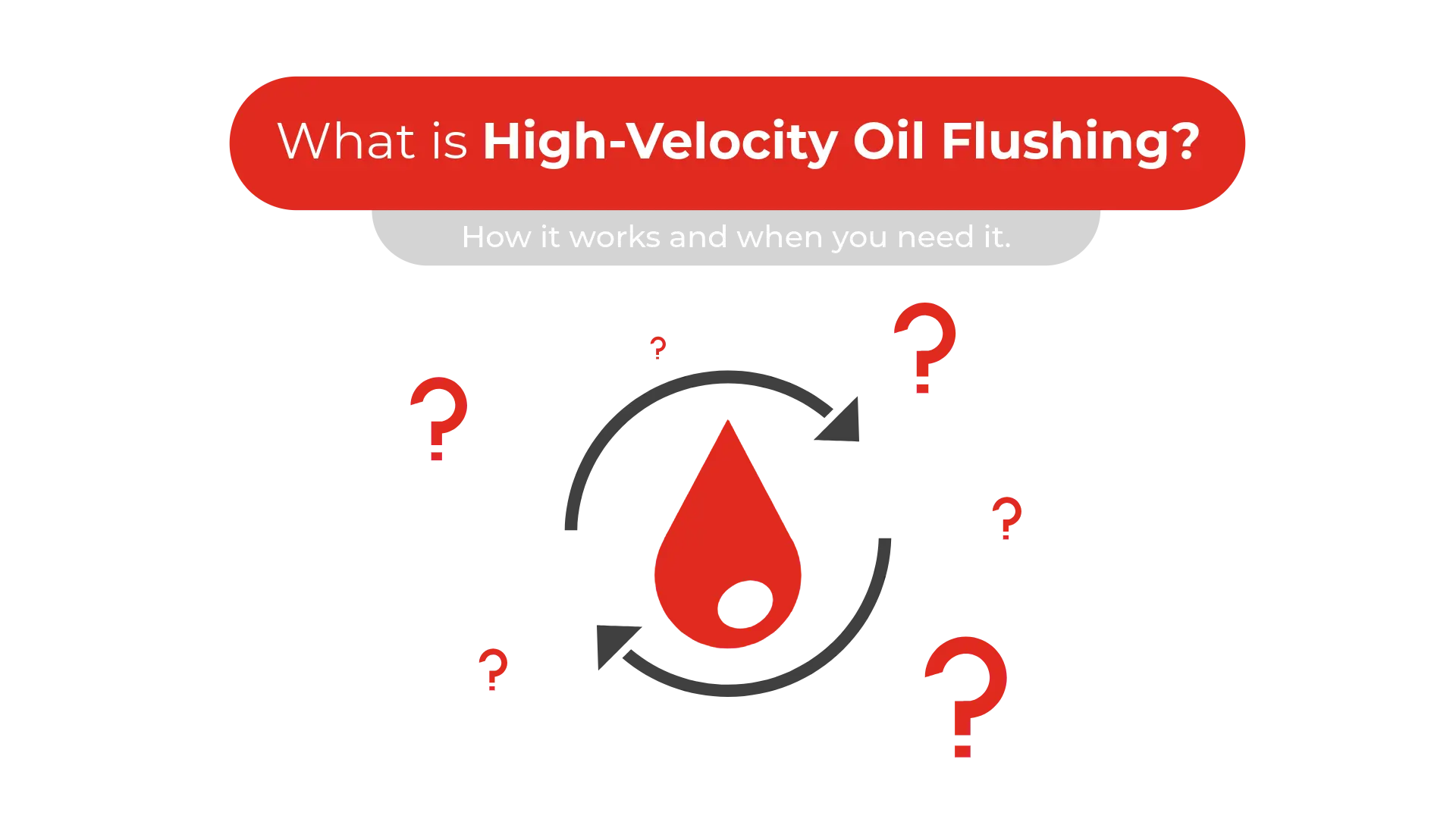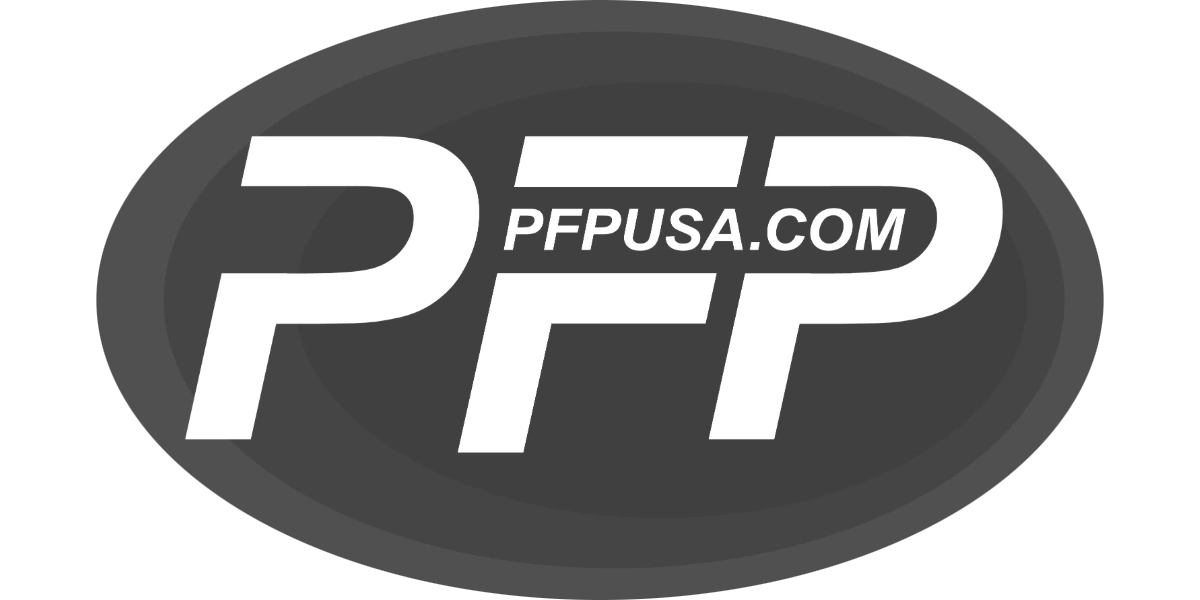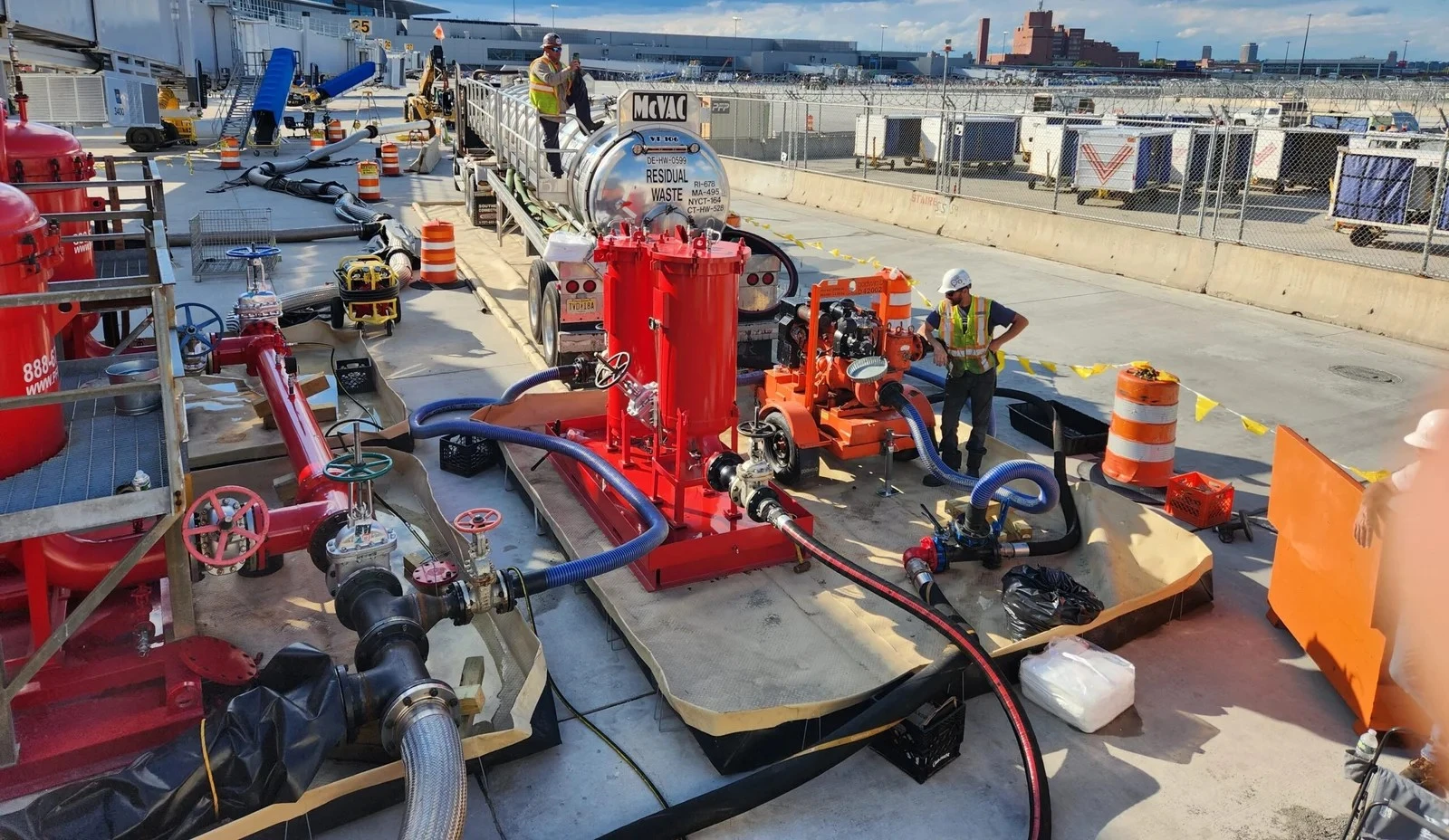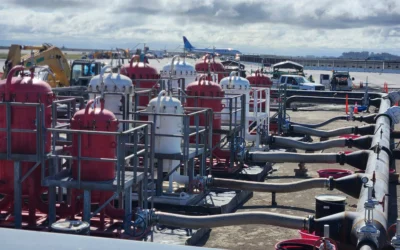
High velocity oil flushing is one of the most effective methods for removing contamination from hydraulic, lubrication, and fuel systems. This service is often employed during commissioning, after equipment repairs, or anytime a system is experiencing contamination.
The goal is simple: force contaminants out of the system using high flow rates, turbulent flow, and continuous filtration until cleanliness targets are met.
Although most applications involve hydraulic and lubrication oils, the same principles also apply to fuel flushing in diesel, marine, industrial, or bulk fuel storage systems. High-flow flushing is a versatile contamination control process used across various fluid types, system sizes, and industries.
High-Flow Turbulent Solutions
High-velocity oil flushing (HVOF) is a system-cleaning process that circulates oil through piping, hoses, manifolds, gearboxes, coolers, and components at a high enough velocity to achieve turbulent flow.
High-Velocity Flushing Operation at Airport. Depicted is a multi-stage filtration configuration
During normal system operation, fluid generally flows in a smooth and layered laminar state. Contaminants settle in low-flow areas, dead legs, elbows, and bottom points of the system. Turbulent flow effectively disrupts these layers, lifting debris and carrying it out to filtration or capture points
Flushing continues until the system reaches specified ISO Cleanliness Codes and moisture levels.
Why Turbulent Flow is Critical
Turbulent flow is the central principle behind every successful flushing operation. When flow becomes turbulent:
- debris is lifted from pipe walls
- varnish layers soften and detach
- sludge and deposits are mobilized
- corrosion products dislodge
- metallic particles are carried out
- contamination hiding in dead legs is exposed
Laminar flow cannot remove entrenched or adhered contamination, regardless of how good the filters are. In essence, filters remove circulating contamination while turbulent flushing removes settled contamination.
This is why high-velocity flushing outperforms standard filtration in system-cleaning applications.
When Does a System Need High-Flow Oil Flushing?
In many facilities, it’s not uncommon for hydraulic, lubrication, or fuel systems to go unchecked for long periods of time. As long as pressures look normal and equipment stays online, it’s easy for facility managers and operators to assume that their fluid is still clean and the system is in good shape.
The reality is that contamination usually builds slowly in the background, accumulating silently over time.
There are also situations where the need is obvious, such as after pipe fabrication, major repairs, or any time a system is opened for mechanical work. New piping, welding, machining, and component changes introduce debris that cannot be ignored. In these cases, flushing is not just a recommendation — it’s expected as part of proper commissioning and start-up procedures.
So what should facility managers and operators look for?
Common triggers will include:
Elevated ISO Particle Counts
A system that fails fluid analysis is often a candidate for flushing. High counts of 4µm, 6µm, or 14µm particles indicate debris circulating or dislodging internally.
Varnish Buildup in Lubrication Systems
Oxidized oil produces varnish that adheres to metal surfaces. Flushing helps remove it and prepares systems for varnish-removal additives or fresh oil.
Sludge, Dark Oil, or Burnt Odors
Degraded oil produces sludge, deposits, and dark discoloration. These often require turbulent flushing to fully remove from systems.
Water Contamination
Free water or high moisture levels promote corrosion, rust, and rapid oil degradation. Severe cases may require both vacuum dehydration AND high-velocity flushing.
Metallic Debris & Wear Metals
Machinery failures, component wear, and new equipment commissioning can introduce metal particles into circuits that standard filtration cannot remove.
Post-Maintenance Work, Rebuilds, & System Overhauls
Any time pipes are opened or components are replaced, contamination risk increases dramatically. Flushing ensures that the entire system is clean before startup.
Fuel System Contamination (diesel, biodiesel, marine fuel)
Although not technically “oil flushing”, the same principles can be applied to diesel flushing, fuel polishing, pipeline cleaning, and storage tank recirculation.
How High-Velocity Oil Flushing Works
High-velocity oil flushing is carried out using temporary high-flow equipment that can move fluid through a system at velocities far greater than normal operation. This requires external flushing skids, multi-stage filtration assemblies, heaters, magnetic separators, and—when necessary—water-removal equipment. These components work together to generate the turbulent flow conditions needed to mobilize debris and remove contamination that standard filtration cannot reach. The overall setup varies based on system volume, fluid type, the severity of contamination, and the cleanliness targets specified for the project.
Lube Oil Flush with Heater Skid Attached.
Flushing duration depends largely on the size and configuration of the system as well as the level of contamination present. Small hydraulic circuits may be completed relatively quickly, while large industrial or multi-loop lubrication systems can require extended circulation time to achieve stable cleanliness levels. The goal is not speed, but consistency. The flushing service will continue until particle counts, moisture readings, and visual inspections all confirm that the system meets the required standards.
Once all equipment is installed and the system is isolated from normal operation, the flushing sequence follows a controlled progression:
1. Flow Rate Calculation
The flushing skid is sized to deliver flow rates high enough to achieve turbulent flow—typically two to three times the system’s normal operating flow.
2. Heating The Fluid (when required)
Warming the oil reduces viscosity, helps loosen varnish and sludge, and increases the effectiveness of turbulent flow.
3. Circulation Through All Piping & Components
Fluid is pushed through piping, manifolds, hoses, coolers, and return lines. Turbulent flow dislodges debris from pipe walls and dead legs.
4. Continuous Filtration
Multi-stage filtration captures all dislodged solids, wear metals, varnish particles, and sludge mobilized during flushing.
5. Supplemental Contamination Control (as needed)
Vacuum dehydrators remove water, clay treaters remove degraded additives, etc.
6. Monitoring & Sampling
Inline particle counters and manual samples are used throughout the process to track progress and determine when target cleanliness is reached.
7. Final Verification & Shutdown
Once ISO Codes, water levels, and visual inspection requirements are met, the system is dried, secured, and prepared for fresh fluid or operational startup.
After the process sequence is complete, the system is stabilized and prepared for fresh fluid or operational startup. Any remaining temporary equipment is removed, final samples are taken, and the system is restored to its normal configuration.
High-velocity flushing is considered successful only when all cleanliness criteria are met and maintained.
Why Industries Rely on High Flow Flushing Services
High velocity flushing is standard in the following industries:
- Power Generation Plants
- Manufacturing & Industrial Facilities
- Aviation
- Marine & Offshore Systems
- Paper Mills
- Steel Mills
- Refineries
- Chemical Plants
- Defense & Military Equipment
- Heavy Machinery
- Hydraulic Power Units
- Turbine Lubrication Systems
These industries depend on continuous & reliable operations. Because of this, contamination is one of the largest contributors to failure and downtime.
According to a study from Noria Corporation, contamination is responsible for an estimated 70-80% of hydraulic and lubrication system failures. High velocity flushing helps operators restore system cleanliness, increases component life, reduces wear and heat generation, stabilizes system pressure, and supports proactive maintenance programs.
It is because of these benefits that so many different industries rely on high flow oil flushing services.
How PFP Offers Turnkey Flushing Solutions
Precision Filtration Products supports high velocity flushing operations with complete turnkey flushing solutions.
PFP supplies the high-flow flushing skids, filtration assemblies, dehydrators, coalescers, magnetic separation tools, and all required auxiliary equipment for connections and setup. Beyond the equipment, we provide experienced personnel and full service execution, offering customers a single source for planning, mobilization, on-site flushing, and verification.
With over 300 years of collective industry experience, we deliver the technical support needed to bring systems back into specification.
Looking for reliable high velocity oil flushing services?
If you’re looking for support on a flushing project, look no further. Contact us today to discuss your project requirements with one of our expert filtration specialists!







